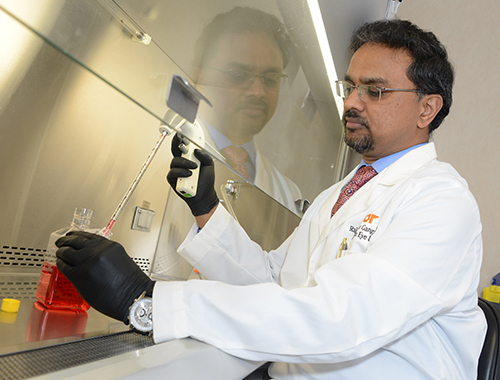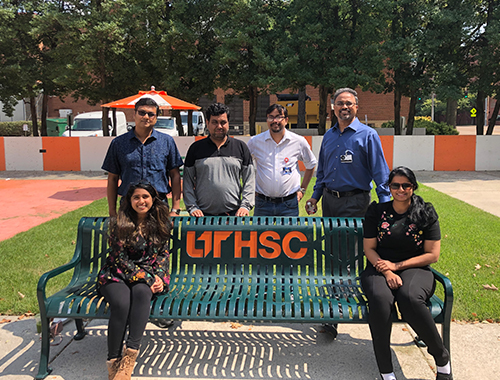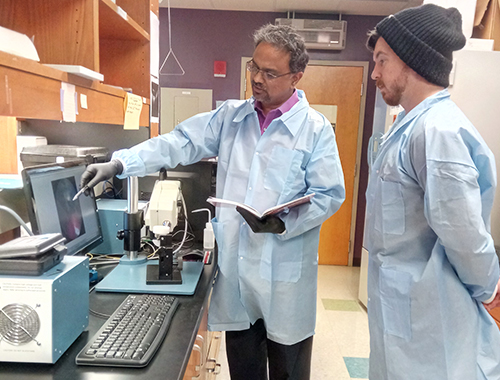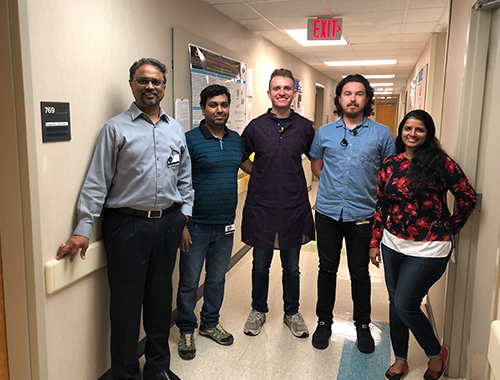 New Vision for Treating the Effects of Diabetes
New Vision for Treating the Effects of Diabetes
Diabetes is among the most prevalent diseases in the world. Though chronic sufferers experience a wide range of complications, one of the most devastating conditions is diabetic retinopathy – a leading cause of blindness in adults across the United States.
The University of Tennessee Health Science Center’s Dr. Rajashekhar Gangaraju stands on the frontlines of the battle against this debilitating condition. Raja is uniquely situated to tackle the treatment of diabetic retinopathy: He’s both a professor of ophthalmology and a cellular biologist with experience in physiology, biochemistry, molecular biology, and pharmacology, with a special interest in vascular biology. Before coming to the U.S. for his post-doctoral fellowship, he gained expertise in treating diabetes by designing new drugs for diabetic complications at a pharmaceutical company in India.
 Nearly every diabetes patient suffers from some form of diabetic retinopathy. The condition damages blood vessels inside the retina, the thin tissue at the back of the eye responsible for converting light into visual information for the brain. The damage occurs when excessive glucose in the blood causes leaks in the light-sensitive blood vessels, allowing blood to escape and spark dangerous inflammation in the retina. Meanwhile, the progression of diabetes hampers surrounding stem cells from interpreting the signals that communicate it’s time to perform the job of patching the leaks. Though treatments for diabetic retinopathy exist, those currently available aren’t effective in all patients and carry a number of unwelcome side effects.
Nearly every diabetes patient suffers from some form of diabetic retinopathy. The condition damages blood vessels inside the retina, the thin tissue at the back of the eye responsible for converting light into visual information for the brain. The damage occurs when excessive glucose in the blood causes leaks in the light-sensitive blood vessels, allowing blood to escape and spark dangerous inflammation in the retina. Meanwhile, the progression of diabetes hampers surrounding stem cells from interpreting the signals that communicate it’s time to perform the job of patching the leaks. Though treatments for diabetic retinopathy exist, those currently available aren’t effective in all patients and carry a number of unwelcome side effects.
Raja’s research hits at the heart of the condition’s pathological effects and aims to fill the gap in current treatment options. He uses scientific problem-solving to approach fundamental questions:
- How can leaky blood vessels be repaired or prevented, and the resulting inflammation suppressed?
- What causes the communication breakdown in retinal cells, and what action will protect the integrity of the cells’ protein machinery?


In pursuit of answers to these questions, Raja and his UTHSC colleagues launched large-scale initiatives in stem cell therapies and drug development. Using stem cells derived from fat tissue, the researchers repurpose the proteins inside these stem cells for the eye. It’s a full-scale investigation, testing the stem cells’ abilities to patch blood vessel holes and create new stem cells. His lab also works to modify proteins and create new compounds, searching for a drug with the ability to protect the integrity of retina cells and testing potential compounds through in vitro and in vivo models.
The hard work is paying off: Raja and his colleagues identified several drugs now undergoing clinical trials for treating diabetic retinopathy. Additionally, the researchers are working with chemists to modify the drugs to develop new, more efficient compounds.
 What’s more, Raja helped develop new technology that shows promise for suppressing inflammation caused by leaky blood vessels. He’s currently working with the University of Tennessee Research Foundation (UTRF) to secure new intellectual property and assess next steps on the path to market. “Along with its potential for treating visual impairment caused by diabetic retinopathy, this discovery carries enormous implications for the eventual treatment of other degenerative diseases, like Alzheimer’s,” remarks UTRF Senior Staff Attorney Lakita Cavin. “Potential application of the treatment toward other diseases not only increases the marketability of the technology, but emphasizes the importance of IP protection.”
What’s more, Raja helped develop new technology that shows promise for suppressing inflammation caused by leaky blood vessels. He’s currently working with the University of Tennessee Research Foundation (UTRF) to secure new intellectual property and assess next steps on the path to market. “Along with its potential for treating visual impairment caused by diabetic retinopathy, this discovery carries enormous implications for the eventual treatment of other degenerative diseases, like Alzheimer’s,” remarks UTRF Senior Staff Attorney Lakita Cavin. “Potential application of the treatment toward other diseases not only increases the marketability of the technology, but emphasizes the importance of IP protection.”
“I’ve been incredibly fortunate that my research has been supported by federal grants, the National Eye Institute, and philanthropic funders,” Raja said, “and now the invaluable help of UTRF in helping move our technology from the lab to the outside world.”